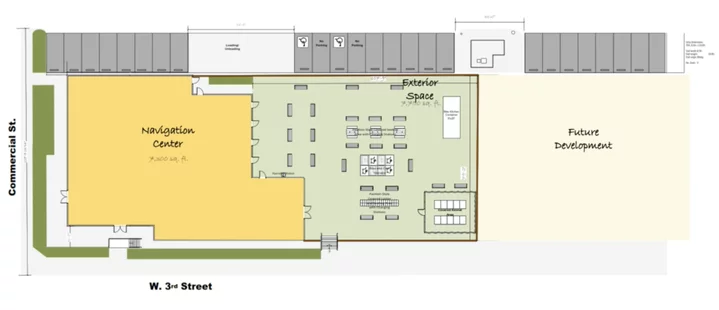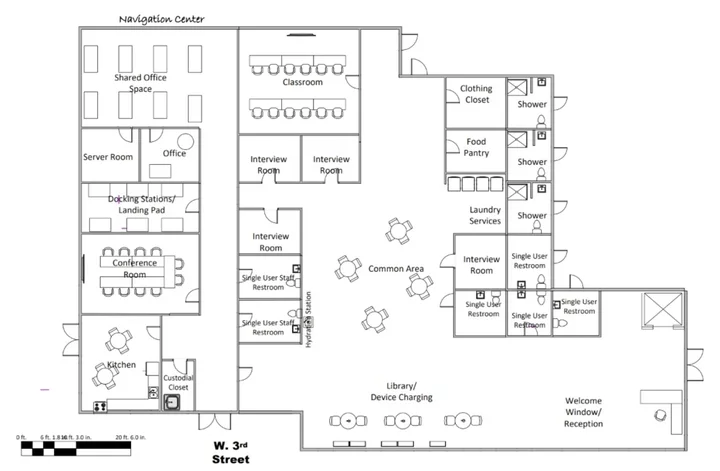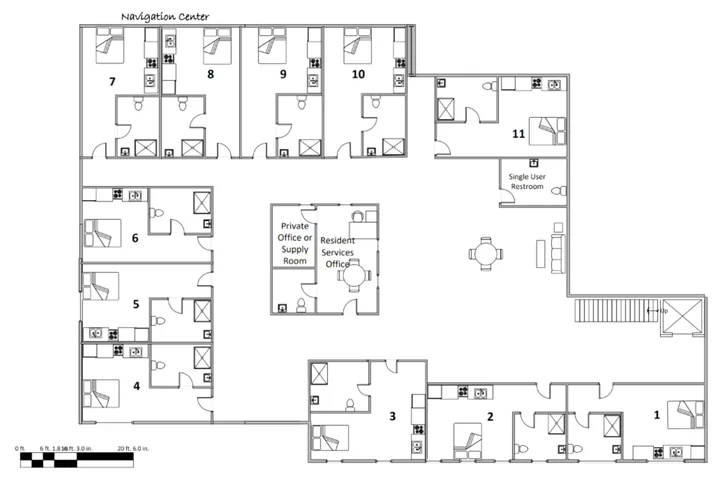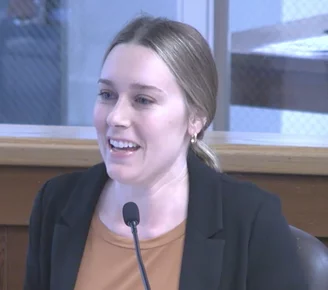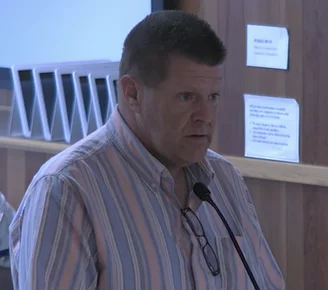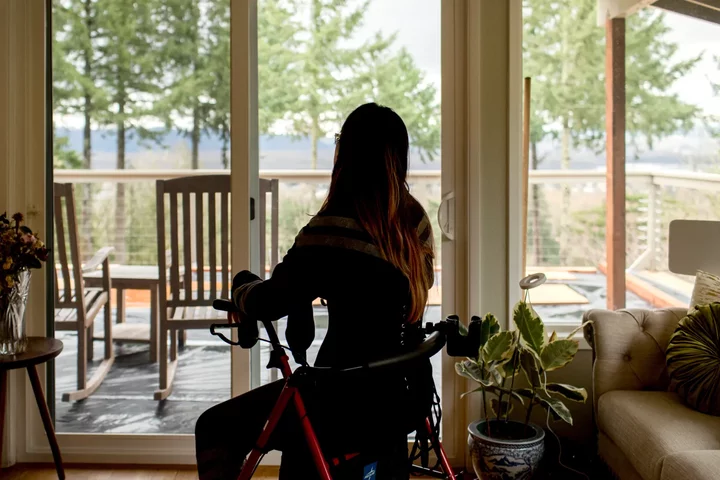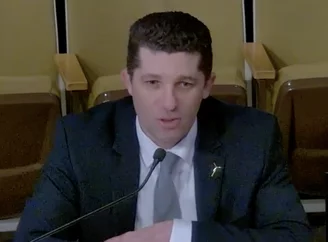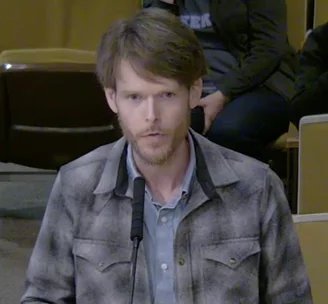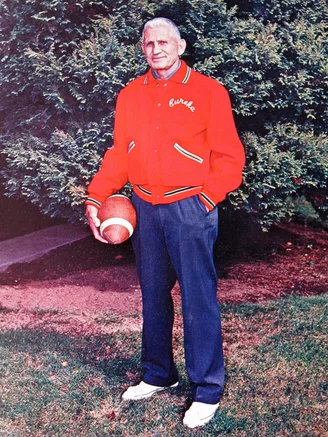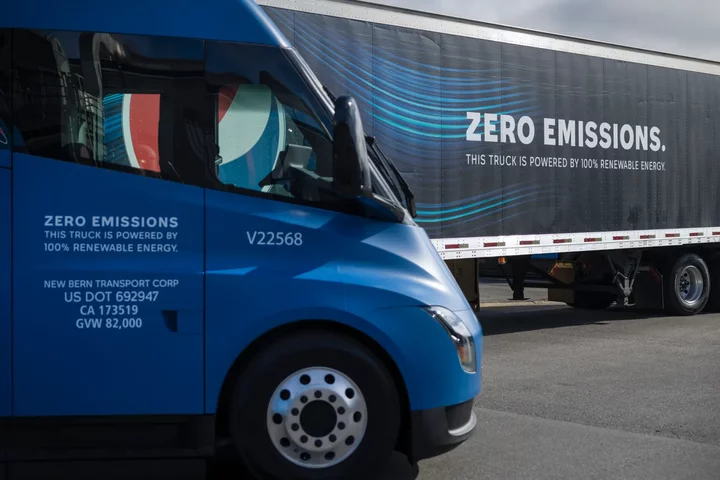The Humboldt Navigational Center Will Begin Providing Services to Humboldt’s Homeless in the Next Two Years; County Staff Says, ‘I Wish It Was Tomorrow’
Isabella Vanderheiden / Thursday, April 27, 2023 @ 3:42 p.m. / Homelessness
An aerial rendering of the proposed Humboldt Navigation Center. | Screenshot
###
PREVIOUSLY:
- ’It Can’t Come Soon Enough’: Humboldt Supervisors Voice Support For New ‘One-Stop Shop’ Center for Homeless Residents
###
The City of Eureka invited community members to a town hall discussion on Tuesday evening to share a progress report on the Humboldt Navigational Center – a resource center for local folks experiencing homelessness.
The facility will be built on the vacant lot across the street from St. Vincent de Paul’s Dining Facility at the corner of West Third and Commercial Streets in Eureka. It will serve as a one-stop shop for the local homeless community, offering access to shelter, affordable housing options, public health benefits, job training and mental health support, all located under one roof.
“County and city staff have been meeting for well over 10 years [to look] for ways to assist our folks that are unhoused, and having a place [for them] to be during the day was always noted as a thing that was really needed,” Connie Beck, said director of the county Department of Health and Human Services (DHHS) said during Tuesday’s meeting.
The Humboldt Navigation Center is modeled after Friendship Park at Loaves & Fishes, a day center for adults experiencing homelessness in Sacramento. Finding a place for homeless individuals to go during the day has been an ongoing issue for the City of Eureka and the local business community, said City Manager Miles Slattery. “[This is] something that’s been a long time coming, and I know this community has been looking for something like this,” he said.
During the day, the navigational center will provide a safe place for people to stay with access to storage lockers, a pet kennel, showers, restrooms, community classrooms, a computer lab, laundry assistance and a clothing closet. Social workers, mental health clinicians and substance use disorder (SUD) counselors would be available on-site as well. And at night, it will provide overnight shelter for local residents experiencing homelessness, including 11 individual rooms for individuals and/or couples.
First floor | Screenshot
Second floor | Screenshot
There will be 24/7 security at the facility and staff will be trained in de-escalation techniques. Staff will work closely with the Eureka Police Department’s Community Safety Engagement Team (CSET), which already works closely with local homeless residents.
Hannah Ozanian, a homeless services consultant and former program director of Friendship Park, has been working with county and city staff to bring the project to life.
“The objective [is] to develop a central location for our local community … to really work together on these local challenges [surrounding] homelessness,” Ozanian explained. “[For] any community that is working in homelessness, the staff and volunteers are typically working so hard to get what they need to get done [that] they’re often burnt out and worn out. What we’re trying to do is not replace anything, but to try to support all these agencies by creating a space to come together.”
It’s important to bear in mind that every individual experiencing homelessness has a unique story, Ozanian said. And along with that, there are many reasons why some folks choose not to seek help.
“We want to create a welcoming, warm space where we can invite folks in, they can use our services, and as we develop trust over time [we will] be able to have those folks take the next step and seek housing,” she continued. “Of course, there will be some folks that will be apt and ready to go right away, but I’m speaking to those harder cases where [we] really need to work on trust in order to take the next step in services.”
Ozanian added that they’re looking for local organizations to be a part of the navigation center. “Not only do we need help but it’s necessary for working on these difficult, challenging and complex issues of homelessness,” she said. “It’s going to take all of us and all of these organizations to come together.”
During the public comment portion of the town hall, Nancy Olsen, CEO of the Eureka Chamber of Commerce, asked about the anticipated timeline for the project. Beck noted that the city and the county are still working with the property owner to negotiate the terms of the lease agreement but estimated that the facility will be fully built out in the next two years. “I wish it was tomorrow,” she said.
“All of the permits are in place, the building permits in place, the design review has been done, all of the planning and zoning permitting is completed – basically now it’s just contractual work that needs to be done,” Slattery added. “That’s the only thing that’s really stopping more construction right now.”
When asked about funding for the project, Beck said the county had received a chunk of change through the state’s Homeless, Housing Assistance and Prevention (HHAP) grant program and the Department of Housing and Urban Development’s Continuum of Care program.
“That’s the funding that’s used just to get this program started,” Beck said. “We also just applied for a grant that would fund the services portion for the next three or four years.”
Olsen also asked how the local business community can get involved once the facility is up and running.
“We hope to have many different opportunities for businesses to come down and volunteer or just tour the facility so they can figure out what where they can fit within the overall project,” she said. “If there’s an artist that would like to come down to do a mural, or a group of nurses that would like to come and do some sort of foot clinic and give pedicures, or if there are just neighbors that can lend us different skills that they have – those are all things we need.”
Ozanian also underscored the importance of building positive relationships with business owners in Old Town. “For instance … if there’s an individual that needs help and is at a neighbor’s doorstep, they could easily call us and we could come and remedy what we could within our capabilities,” she said.
St. Vincent de Paul board member and volunteer coordinator Bob Santilli said he was somewhat concerned with the issue of “overlapping assistance to the community” and the possibility of having to compete for funding.
“But I’m happy that Hannah [Ozanian] and whoever else has listened and I don’t see things that we’re doing already being reapplied under that concept. I’m happy for that,” he said. “We want to have a kind of overlapping collaboration of sorts in that region to hopefully have a larger impact on what we’re trying to address.”
Eureka City Councilmember Renee Contreras de Loach asked if they could add more shelter space to accommodate more people in the facility or include a covered area outdoors.
“There is a space for another building on the [East] side of the current location that we’re that we’re looking at [but] we’re going to start with this one,” Beck said. “This will be phase one, and then see where we go from here. We could definitely use more office space down there by that location, and if we were to do that, then we would want more housing above that space. Anywhere we can get more housing we want more housing.”
Contreras de Loach also asked about the number of animal kennels. Ozanian said there would be eight to ten kennels on-site but said the plan “could easily be modified.”
As a formerly unhoused person, Vernon Price asked how he could participate to “pay it forward.”
“I’ve been housed now five years and this is something that has really been a desire in my heart is a navigation [center], and I know that has been in the hearts of some people that have been on the street for quite some time,” he said. “My question here is about volunteerism [for] people with lived experience: How can I pay it forward?”
Beck recognized Price and encouraged him and others to attend future public meetings and continue to provide feedback to staff.
Eureka Mayor Kim Bergel expressed her gratitude to county and city staff for their work on the project and encouraged community members to “grab an oar” and help out where they are able.
“This is a community issue and it needs a community solution,” she said. “That could mean dropping off your old clothes at the facility, dropping off a bag of toothbrushes; it doesn’t necessarily mean you have to engage with people, although that would be amazing as well.”
BOOKED
Today: 5 felonies, 11 misdemeanors, 0 infractions
JUDGED
Humboldt County Superior Court Calendar: Friday, Jan. 2
CHP REPORTS
Us101 S (HM office): Traffic Hazard
150 Nelson Ln (HM office): Traffic Hazard
1600 Mm36 E Hum 16.00 (HM office): Closure of a Road
9731 Mm101 N Men 97.30 (HM office): Trfc Collision-No Inj
Ryan Creek Rd / US101 (HM office): Traffic Hazard
ELSEWHERE
RHBB: Highway 36 Closed Again at Grizzly Bluff Slides After Boulder Hits Vehicle
RHBB: City of Trinidad Urges Residents to Boil Water After Repairing Water Main Leak
Long COVID in California: ‘A Pandemic of Loneliness and Social Isolation and Rejection’
Kristen Hwang / Thursday, April 27, 2023 @ 7:33 a.m. / Sacramento
Mindy Lym has been living with long COVID since the summer of 2022. After months of bed rest, she’s now living in Camas, Washington, where her symptoms are improving but are still a day-to-day challenge. Photo by Celeste Noche for CalMatters
A bout with COVID-19 two years ago left Mindy Lym with such severe sensitivities to light and sound that she and her partner left their San Francisco home and moved to rural Washington, where there were fewer triggers. In the past two months, she has paid more than $7,500 out-of-pocket for medical care. Although she can afford it, she knows few people can do the same.
Stephen Mintz gets just $60 per week from disability, which he receives after the chronic fatigue from COVID-19 kept him from regular work. He spent all of his savings and borrowed money from family. Without more relief payments from the state, he doesn’t know how he’ll pay his bills.
COVID-19 sent Janine Loftis to the hospital in 2020. She relies on a caretaker after lingering symptoms like brain fog, pain and fatigue keep her from cooking or cleaning. But when Loftis’ caretaker took a month-long leave of absence, shortages ravaging the health care workforce made it impossible to find a replacement.
These are three out of countless stories of long COVID among Californians. Recent CDC surveys suggest 5.5% of California adults — roughly 1.5 million people — currently experience the ill-defined, mysterious and often debilitating collection of symptoms that make up long COVID. A majority of them, 82%, have some limits on their activity. While most of society rushes eagerly back to pre-pandemic life, these patients, known as “long haulers,” have been largely left behind by their communities, doctors and policymakers.
“It’s a pandemic of loneliness and social isolation and rejection,” said Ibrahim Rashid, a long hauler and founder of Strong Haulers, a startup app designed to make chronic symptom management easier.
These patients, known as “long haulers,” have been largely left behind by their communities, doctors and policymakers.
California long haulers can face years-long wait times to get into specialized clinics. Oftentimes they have to fight for disability payments or to be taken seriously by doctors. Lawmakers, despite holding hearings on the issue last year, have not introduced any proposals this session to assist long haulers. A budget proposal to increase long COVID clinic capacity at University of California health centers failed last year, and it’s unlikely with an expected state budget deficit that anything new would make it off the ground now.
Former state Sen. Dr. Richard Pan, who co-chaired a special hearing on long COVID last year, told CalMatters in February ahead of the deadline to introduce new bills that he hoped “people are paying attention to this” because long COVID will put new stressors on the health care, mental health and disability systems.
The Senate Special Committee on Pandemic Emergency Response was not reinstated this year. A spokesperson for Sen. Josh Newman, a Democrat from Fullerton who chaired the committee last session, said there hasn’t been any conversation about long COVID since last year.
Patients at the forefront
Instead, the policy legwork has fallen on two people: Lisa McCorkell, co-founder of the Patient-Led Research Collective who has suffered from long COVID since March 2020, and Art Mirin, whose daughter has a similar post-viral condition called myalgic encephalomyelitis/chronic fatigue syndrome. Together, McCorkell and Mirin have drafted budget proposals, solicited letters of support from disability advocacy groups, and met with legislators and staffers. They’re doing the work that political power players pay lobbyists millions of dollars to organize — so far to no avail.
“One of the big issues with long COVID…is that the people who are the most motivated to do something about it have the least amount of energy and ability to cause a scene,” McCorkell said.
Despite struggling with postural orthostatic tachycardia syndrome, a blood circulation disorder that can cause fatigue and brain fog, as well as other disabling symptoms, McCorkell has testified before Congress on long COVID, conducted research and pushed for California to do more for the population.
She and Mirin wrote last year’s budget proposal for the state to fund research, training and treatment centers at UC medical campuses and other academic centers. Mirin said it has been challenging to find a champion for this issue.
“People will say they support one thing or another, but when it comes down to an official public request, other things have a way of coming into play,” Mirin said.
Although five UC medical campuses have long COVID clinics, demand far exceeds capacity, said Dr. Anne Foster, chief clinical strategy officer for UC Health Systems.
“There are just a lot of patients out there,” Foster said. UC Health supports McCorkell and Mirin’s proposal but new state funding isn’t available, she said.
Officials with the California Department of Public Health plan to create a new COVID-19 Control Branch to monitor variants and outbreaks and support long COVID research, said State Epidemiologist Dr. Erica Pan. The department is using some money from last year as well as seed money from the state’s $1.8 billion long-term COVID-19 preparedness plan to open the branch. However, proposed budget cuts make ongoing funding undertain.
“We are looking at that and trying to advocate for ongoing resources,” Pan said.
Without additional money from the state, Foster said UC Health has pivoted to developing a free continuing education training program for doctors on best practices to treat long COVID patients.
McCorkell and Mirin say the training modules aren’t perfect, but they’re an important resource for primary care doctors, especially considering most people in the state live too far from a specialized clinic to get help.
Many doctors haven’t heard of long COVID
Stephen Mintz of Fresno is one such patient living too far from specialized care.
Mintz avoided COVID-19 for more than two years, but in August he went to a bar to celebrate his 59th birthday. It’s there where he most likely contracted the virus. By September, Mintz found he didn’t have the physical or mental stamina to do much of anything. After two-and-a-half hours of activity, his limbs would get heavy and his thoughts would muddle.
“You could almost set a clock to it,” Mintz said. “Suddenly it would be very difficult to put one foot in front of the other.”

Stephen Mintz sits at the side of his bed in his apartment in Fresno on March 3, 2023. Mintz was diagnosed with COVID-19 in September and has had chronic fatigue since then. Photo by Larry Valenzuela, CalMatters/CatchLight Local
In January, Mintz was stacking chairs at a local bar where he works as a security guard. Within 10 minutes he got dizzy and couldn’t lift his arms anymore. It’s a common condition associated with long COVID called post-exertional malaise — pushing through the fatigue can worsen symptoms.
“I actually cried then. I’ve been depressed over this and frustrated,” Mintz said. “I couldn’t believe I’m so weak.”
Mintz went to his primary care doctor in Fresno for help. He said he thought he had long COVID and was met with skepticism.
“His first reaction was that he hadn’t really heard of it,” Mintz said.
On his disability paperwork, Mintz said the doctor wrote “general malaise and short-term amnesia” because he didn’t know how to diagnose Mintz and told him to call UC San Francisco, nearly 200 miles away, for advice.
“The doctor there said ‘Um, well, if you lived here you could be part of a research study,’” Mintz said.
“I’ve been depressed over this and frustrated. I couldn’t believe I’m so weak.”
— Stephen Mintz, patient with long COVID
It’s a common experience among people with long COVID-19. Though the pandemic has thrust post-viral illnesses into the spotlight, most doctors still don’t have the experience to treat the collection of more than 200 symptoms that make up long COVID.
Each new variant of COVID-19 also changes which symptoms are most common, making it doubly difficult for the average primary care doctor to diagnose, said Dr. Nisha Viswanathan, a primary care physician at UCLA Health’s long COVID clinic. The “vague nature” of many symptoms like fatigue and insomnia also lead to misdiagnosis and frustration among patients.
“It’s really challenging,” Viswanathan said. “If you’re not seeing a certain volume of long COVID patients, it can be difficult to recognize when a patient may be having it versus not.”
Mindy’s story
COVID-19 first hit Mindy Lym, a 37-year-old San Francisco native, like a mild flu with a fever and congestion. But on day five of her illness she looked at a text from her girlfriend who was isolating in a separate room and couldn’t make sense of the words. It looked like gibberish.
“That really scared the shit out of me,” Lym said. “I knew it had gotten into my brain.”
“We moved because of my long COVID. Being in a city with city noises…was completely untenable.”
Mindy Lym, patient with long COVID
She has spent every day since then chasing after an elusive recovery. Like McCorkell, Lym developed postural orthostatic tachycardia syndrome and wears compression garments like stockings and a corset to improve blood circulation. She also has mast cell activation syndrome, which causes an immune response similar to a severe allergic reaction as well as chronic inflammation.
For three months, Lym, who formerly worked as a music teacher and theater performer in San Francisco, could barely walk and needed a full-time caretaker to dress and bathe. Even soft noises and dim lights caused her “unbearable pain.” When construction outside her house led to weeks of jackhammering, Lym developed PTSD.
“We moved because of my long COVID,” Lym said. “Being in a city with city noises…was completely untenable.”

Mindy Lym has been living with long COVID since the summer of 2022. Photo by Celeste Noche for CalMatters
In September 2022, before moving out of state to rural Washington, Lym called the Post-Acute COVID-19 Syndrome clinic at Stanford Health Care. The clinic scheduled an appointment for her in October 2023.
“The demand has been extremely high,” said Dr. Linda Geng, co-director of Stanford’s long COVID clinic. The clinic sees about 12 to 15 new patients each week and has an eight-month average wait time.
Yet even as patients like Mintz and Lym struggle to get into a specialized clinic, UCLA physician Viswanathan said she has heard from multiple colleagues at other facilities that are considering closing their long COVID care clinics or reducing hours. Health systems are strapped for cash and facing a dire workforce shortage, said Dr. Anil Keswani, chief medical officer at Scripps Health in San Diego.
“We have increased supply costs. We have increased pharmacy costs. We have increased labor costs,” Keswani said. “How do health care systems invest in programs like long COVID clinics, like hiring more clinicians? Health care organizations have been battered over the last few years, but I don’t see any government relief.”

Some of Mindy Lym’s medications and supplements living with long COVID. Lym has been living with long COVID since the summer of 2022. After months of bed rest, she’s now living in Camas, Washington with her girlfriend where her symptoms are improving but are still a day to day challenge. Photo by Celeste Noche for CalMatters.
Nearly one third of the long COVID clinics in California told CalMatters they need more resources to expand capacity, increase awareness or train primary care doctors to recognize the signs.
“Ultimately, the real way we’re going to be able to expand or even keep these clinics functional…is going to probably be support at a state or federal level,” Viswanathan said.
Support also needs to come in the form of patient navigators and case workers for patients with long COVID, Viswanathan said.
Janine’s story
A patient navigator could help someone like Janine Loftis, who has battled for nearly two-and-a-half years to be seen by a long COVID specialist.
Loftis turned 73 in January, but physically, she feels much older. In November 2020, after laying in “the house for two weeks not knowing what to do,” Loftis called an ambulance. It was the middle of the night, she had COVID, and her oxygen level dropped. Family and caretakers couldn’t check on her for fear of infection. By the time Loftis was admitted to the hospital, she had viral and bacterial pneumonia and blood clots forming deep in her veins.
Loftis was already disabled from previous spinal injuries, but the persistent aftereffects of COVID-19 have floored her.
“It’s embarrassing how little I can do on my own,” Loftis said. “My body gives out on me. Things are just lost to my mind.”

Janine Loftis, 73, at her home in Elk Grove on April 26, 2023. Loftis suffers from long COVID; lingering symptoms from the original infection such as brain fog and chronic fatigue. Photo by Rahul Lal for CalMatters.
The chronic fatigue and brain fog prevent her from going to in-person church services, and she recently gave her dog of nine years, Lily Grace, to an adoption agency after caring for her got too hard. When Loftis’ home caregiver took a leave of absence for four weeks, she couldn’t find a replacement. Long-standing workforce shortages intensified acutely during the pandemic, leading to “high demand and low options.” Without anyone to help her, Loftis “struggled really horribly” to manage daily tasks.
“I have a COVID test sitting out because I felt so bad yesterday. I thought, ‘Do I have it again?’” Loftis said.
Juggling doctors appointments and navigating the byzantine health insurance system is an added obstacle for Loftis.
“My head is spinning just trying to talk about it again,” she said. “I don’t know how lay people, especially disabled ones with a lot of distractions like pain or like me with brain fog, how they…understand it.”
“It’s embarrassing how little I can do on my own. My body gives out on me. Things are just lost to my mind.”
— Janine Loftis, patient with long COVID
Two months ago, Loftis finally convinced her primary care doctor to refer her to the UC Davis long COVID clinic, but her paperwork is “lost in a pile of things that need authorization.”
“It takes everything just to keep up with anything,” Loftis said. “When things get ignored or I don’t know the process, I just have to wait for it to play out. I’m the middle man. I can’t do anything.”
UC Davis Health did not make anyone from its long COVID clinic available for an interview. When asked about clinic capacity, the media relations division said in an unattributed email the Post-COVID-19 Clinic has the ability to treat “an infinite number of patients.”
Hope… with some caveats
There is a chance for recovery. Anecdotally, long COVID specialists interviewed by CalMatters said even if patients don’t make a full recovery, most see significant improvement over time.
“You look a year or 18 months out and the majority of people have had improvement if not complete resolution,” said Dr. Caitlin McAuley, a primary care physician at the USC Keck COVID Recovery Clinic.
A large study out of Israel found that among patients with mild COVID-19 infections, most symptoms resolved within one year.
Other studies, however, paint a less rosy picture, with few patients reporting full recovery. One study on French patients found 85% still reported long COVID symptoms a year after onset.
On the plus side, Mintz, who has had long COVID for eight months, has slowly regained his energy over time. He can go five or six hours without crashing, compared to two hours in January.

Mindy Lym has been living with long COVID since the summer of 2022. Lym keeps a food diary to note her reactions to different foods. Photo by Celeste Noche for CalMatters
And Lym, who has had long COVID for nine months, has also seen a marked improvement. In February, she enrolled in a private long COVID research and treatment clinic. Together with her doctor, Lym discovered certain foods exacerbated her most severe symptoms. Now, she has an 18-page list of foods she can’t eat and takes a medley of antihistamines, blood thinners and supplements daily. Though Lym is still disabled, her sensory issues are 95% better and her energy has steadily improved.
“I feel like I have my personality back. My fatigue is no longer limiting how I express myself…which is amazing,” Lym said.
But Lym’s clinic isn’t covered by insurance, and costs $1,000 per month plus the cost of any tests the doctor orders.
“It’s not accessible,” Lym said. “I know there are so many people going through what I’m going through but don’t have the resources.”
###
CalMatters.org is a nonprofit, nonpartisan media venture explaining California policies and politics.
HUMBOLDT TODAY with John Kennedy O’Connor | April 26, 2023
LoCO Staff / Wednesday, April 26, 2023 @ 5:02 p.m. / Humboldt Today
HUMBOLDT TODAY: Eureka High’s old gym is getting a long goodbye; Englund Marine is set to open its sparkly new location; plus, Tuesday’s commotion on the Eureka Waterfront turns out to be… not as reported. Those stories and more in today’s online newscast with John Kennedy O’Connor.
FURTHER READING:
- Costs Up, Revenues Down: Measure Z Revenues Are Tanking After a Year of Economic Downturn
- Eureka High Athletics Boosters are Gonna Send Out The Glorious Old Jay Willard Gym in Style Before it is Torn Down
- CONVERSATIONS: Raelina Krikston Still Thinks the Rent is Too Damn High, and That’s Just the Start of the Problem
HUMBOLDT TODAY can be viewed on LoCO’s homepage each night starting at 6 p.m.
Want to LISTEN to HUMBOLDT TODAY? Subscribe to the podcast version here.
Costs Up, Revenues Down: Measure Z Revenues Are Tanking After a Year of Economic Downturn
Isabella Vanderheiden / Wednesday, April 26, 2023 @ 3:07 p.m. / Local Government
Screenshot of Tuesday’s Humboldt County Board of Supervisors meeting.
###
The Humboldt County Board of Supervisors took its first look at this year’s list of Measure Z spending priorities for the upcoming fiscal year during this week’s meeting. Unfortunately, it looks as though the county is in for another year of financial distress.
“This year is a difficult year,” said County Administrative Officer Elishia Hayes said during Tuesday’s meeting. “We [don’t] have a lot of money to go around and [there are] a lot of tremendous needs across our communities.”
By the end of the meeting, everyone agreed — the money the county is taking in through Measure Z is dropping, the bulk of it is already committed to ongoing projects, and there’s no obvious corner to be cut.
Since its inception in 2014, Measure Z, the county’s half-cent sales tax for maintenance and enhancement of public safety and essential services, has proven to be a success. The measure has helped to fund hundreds, perhaps thousands of programs and individual projects over the years.
However, the last year has had a significant impact on the Measure Z fund. Due to a reduction in economic activity across the county, sales tax revenues have dropped, cutting millions of dollars from the county’s projected income. To make matters worse, inflation and rising costs have increased county expenses, including higher employee salaries and more expensive benefits, leaving significantly less funding for Measure Z allocations.
The county is expecting to bring in $12.67 million in Measure Z revenue for fiscal year 2023/24, $1.8 million less than staff’s estimate for the current fiscal year, according to Deputy CAO Sean Quincey. Current expenditures are expected to exceed $12 million, leaving approximately $623,429 for discretionary spending.
Quincey floated a possible idea that the staff had come up with: Eliminate some county jobs that have remained empty for some time.
“I will note that in the current year, when we went down the list and allocated more projects or funded more projects, the board allocated 16 additional county staff positions and of those positions, only one of them is currently filled at the time,” Quincey continued. “A topic for your board to consider as we look ahead to [fiscal year] 2023/24 is what to do with those positions that were allocated in 2022/23.”
Deallocating all of the positions would save the county approximately $1.6 million in the coming fiscal year, according to the staff report. Public Works is the only department that has used one of the vacant positions.
During public comment, Public Works Director Tom Mattson chose not to speak to the current funding allocations being discussed, noting “it is what it is” and “there’s just no money for anything extra.” Instead, Mattson asked the board to keep its word and continue to fund positions that were allocated last year.
“It’s not for lack of recruiting that we have not been able to hire equipment operators or maintenance workers,” he said. “The mowing crew – we have ordered the mowers already and they are being constructed. … This is going to leverage significant additional funding if we can get these positions filled. … We believe we have a solution that’s going to make us very competitive in the market and within our budget. I would just caution you … to not cut the positions that were already allocated last year.”
Meanwhile, several representatives from organization that are receiving ongoing funding from Measure Z — particularly those that deal with emergency services like policing and fire protection — made the case for continuing those programs, rather than cutting back.
Several representatives of the City of Fortuna and the Fortuna Police Department also spoke during public comment to advocate for Measure Z funding. Citing the dramatic rise of fentanyl abuse and overdose-related deaths in Humboldt County, Fortuna Mayor Tami Trent underscored the need for a robust drug task force.
“I know you have a very tough job ahead of you with very little money to fund the deserving applications,” she said. “Tracking [the fentanyl] mortality rate … Humboldt County is significantly higher than any other California county. Fortuna is one of the agencies that has been able to have [an officer on the drug task force] for eight years now and it’s been funded through the county. … The drug task force has been very successful in the whole county and it does save lives getting these drugs off the street.”
Fortuna Police Chief Casey Day echoed Trent’s concerns and emphasized the importance of having a school resource officer on duty to facilitate drug education in schools throughout the Eel River Valley, not just Fortuna.
Representatives of the Humboldt County Fire Chiefs’ Association and local volunteer fire districts advocated for their chunk of funding but also questioned the sustainability of Measure Z amid increasing county costs.
“There are no salaries involved [for us], so every year we have to queue for funding,” said Telegraph Ridge Volunteer Fire Chief Peter Lawsky. “We come hat in hand every year to try and adequately fund the volunteer fire departments. We provide emergency services in all the rural areas. … We continually need funding to be able to provide these services.”
Lawsky added that the $1,066,051 supplemental budget request for the Humboldt County Fire Chiefs Association would contribute to dozens of separate agencies across the county.
Many of those districts, especially in rural Southern Humboldt, have been using the same engines and equipment for decades.
“If we asked our sheriff’s deputies to ride the calls in 1990s trucks and then do it for free, they’d have a hard time doing that. That’s arguably what we’re going to have our volunteers do,” said Shelter Cove Volunteer Fire Department Chief Nick Pape. “If we only have 15 sets of fire turnout gear, we’re not going to be looking for [additional] firefighters until the funding is available. We have fire departments in our area that are literally funding their department by selling blackberry pies and hamburgers. … If we do not get the funding for that, these departments don’t have a plan B or C.”
But several people intimately involved with the spending of Measure Z funds over the last few years questioned whether this was the best mechanism to fund these service. Before returning to the board for discussion, Justin Robbins, chair of the Measure Z Citizens’ Advisory Committee, urged the board to reevaluate the sustainability of Measure Z.
“And that’s really, really difficult to do … given all of our challenges,” he said. “What we need for stable funding is stable economies and economic growth in our county. This last year was very, very challenging given the amount of funding that was available, and I support the recommendation that was made by the committee. I also want to say that I would want to advise my fellow committee members … and the Board of Supervisors that I think what’s important going forward … is that we fund projects that leverage other funding sources that leverage creativity and leverage in-kind labor.”
Glen Ziemer, vice-chair a former member of the advisory committee, warned that increasing payroll expenses and other county expenditures will inevitably “consume the totality of the fund.”
“Unfortunately, there have been two factors that have advanced that process,” Ziemer explained. “The first being the significant compensation package that was offered to the county’s law enforcement officers. Certainly, they deserve it … but the simple fact is you raised the cost of your law enforcement component somewhere north of 30 percent. The second factor that complicates Measure Z specifically is the fact that during the period of time that you didn’t have a functional auditor-controller, the fund balances were never identifiable.”
To avoid exhausting the Measure Z revenue and to “bring back a representative and transparent process,” Ziemer suggested that the Board of Supervisors divvy up the fund into internal and external divisions. “You are already at the point … where there is no capability for external agencies to be funded,” he said. “If, in fact, the goal of Measure Z is to provide the best service to the community, you cannot make a credible argument that that’s accomplished simply by using it as a payroll funding mechanism for the county position.”
One by one, each member of the board acknowledged the difficult decision at hand.
“All of these applications are worthwhile,” Second District Supervisor Michelle Bushnell said. “[This is] painful work, especially when there’s not enough funding.”
Hayes noted that the county had “roughly $200,000 to $300,000” in addition to the $623,429 in projected available funds for the next fiscal year. However, “due to the volatility of the revenues of Measure Z,” she asked the board to hang onto those dollars for the time being.
“We’re in there looking every single month to see what kind of change is occurring and a swing of a half million dollars is commonplace right now,” she said. “It’s very difficult for me to say that we will definitely have funds to roll over and carry forward from the current year.”
Fourth District Supervisor Natalie Arroyo also expressed her support for the ad hoc committee’s list of recommendations and acknowledged the difficult decision facing the board. “You know, to sit here and go through the list of projects and decide which is the most needed or wanted in their community really is like cutting the baby in half,” she said. “I sort of hate that euphemism, but it really speaks to how difficult it is and how valuable all of these projects are.”
Arroyo said she would be in favor of a percentage-based spending allocation plan that would be reflective of years past to help guide the decision-making process and suggested staff bring back additional information on the subject at a future meeting.
Third District Supervisor Mike Wilson agreed with Ziemer’s previous comments, noting that, while Measure Z has been “very successful,” it has also backed the county into a corner.
“I wouldn’t mind some analysis around that to really take a look at where we’re at … and see what we’ve allocated and kind of consider permanent these days, especially if we’re going to be going into more budget discussions. … I would recommend that there be some interface with some members of this board [and the ad hoc committee] to have those conversations about the long-term elements of this.”
Wilson added that he didn’t feel comfortable making a decision on the list of Measure Z recommendations just yet.
Fifth District Supervisor and Board Chair Steve Madrone said it “would be foolish” to move ahead with the ad hoc committee’s recommendations without further information. However, Madrone said the board could take a couple of smaller actions to move the process forward, such as approving staff’s recommendation for the supplemental budget for the Humboldt County Fire Chiefs’ Association. He also suggested appointing two board members to the Measure Z Citizens’ Advisory Committee to “really look at how to fix what is obviously becoming somewhat broken.”
“This is kind of the start of our delving into our whole budget in a way,” he said. “Even though it’s not, it’s just Measure Z, we are delving into our budget and we already know that our revenues are way down, and our expenses are up. That’s not a pretty picture. We’re going to have to dig deep to deal with that and often that requires us to use our reserves.”
After some additional discussion on the matter, Arroyo made a motion to approve the supplemental budget request for the Fire Chiefs’ Association and authorize the CAO to allow flexibility within the spending plan. She also asked the CAO’s office to bring back recommendations about policy to establish guidance for one-time projects, a percentage-based allocation plan and to appoint two members of the board to the ad hoc committee. Bushnell seconded the motion.
The board agreed to appoint Bushnell and Wilson to the ad hoc committee. The motion passed in a unanimous 5-0 vote.
The board will revisit the remaining Measure Z recommendations at a future meeting.
Eureka High Athletics Boosters are Gonna Send Out The Glorious Old Jay Willard Gym in Style Before it is Torn Down
Stephanie McGeary / Wednesday, April 26, 2023 @ 1:37 p.m. / Education , Event
After more than 70 years of hosting Loggers’ games, rallies and other community and school events, Eureka High School’s historic Jay Willard Gymnasium will soon be torn down, and a series of special events will be held this weekend to give the gym a proper farewell.
The event, put on by the EHS Athletic Boosters, will span across three days and includes a basketball shoot-out contest on Friday, a “Last Classic” dinner with special guest speakers on Saturday and a final walk through the memory-filled gym on Sunday.
Shayna Matteoli of the Athletic Boosters has been putting a lot of effort into the goodbye event, tracking down alumni and hall-of-famers to speak during the Saturday night dinner. As an EHS alum and past athlete, with two children at the school now, Matteoli said it’s important to pay homage to the gym that holds so many memories.
“It’s a historical gym,” Matteoli told the Outpost over the phone on Wednesday morning. “I think it’s really important to people — not only people who went there but also other people in the community.”
The event meant not only to commemorate the gym itself but also to honor the person for whom it’s named, the late EHS coach Jay Willard (1898-1973). Willard taught physical education at the school from 1927 to 1963 and coached football, basketball, baseball, track and golf for various lengths during that time. Willard received many honors over the years, including being named teacher of the year, and he was added to the California Coaches’ Association Hall of Fame. You can read more about Coach Willard’s legacy in this tribute article from the Humboldt Historian.
Willard’s granddaughter, Melinda Sheridan, will be speaking during the Saturday night event after traveling all the way from British Columbia to honor her grandfather. There will also be many speakers, including past coaches and athletic directors, Loggers hall-of-famers and other alumni.
Though many folks are fond of the Jay Willard Gym, which was built in 1950, Eureka City Schools had seismic and economic concerns with the aging building and determined that it would be best to build an entirely new gym. After breaking ground in 2020, the new facility is nearly complete and expected to open by the beginning of the next school year. Demolition of the old gym is expected to begin after school lets out in June.
Matteoli said it’s bittersweet to say goodbye to the old gym and welcome in the new. “Our new gym is beautiful, but it’s nothing like the old one,” she said.
The farewell event will take place this Friday, April 28 through Sunday, April 30. The Saturday night event costs $60 per person and includes a dinner and silent auction, in addition to the guest speakers. All of the proceeds from the tickets will go directly toward supporting the EHS athletics department. But, if the cost is too steep for you, the Friday night basketball event and the Sunday farewell visit are both free and open to the public.
You can find tickets and more information at this link. You can email any questions to eurekahighboosters@gmail.com.
CONVERSATIONS: Raelina Krikston Still Thinks the Rent is Too Damn High, and That’s Just the Start of the Problem
LoCO Staff / Wednesday, April 26, 2023 @ 7:41 a.m. / People of Humboldt
Last year, local small business owner Raelina Krikston ran for Arcata City Council on a pro-housing, pro-renters’ rights platform. She ended up third out of six candidates running for two open seats, finishing behind an incumbent and a longtime member of the city’s planning commission.
Shortly after the election, Krikston and her partner were evicted from their home in the Westwood Garden Apartments, after leading a fight against the owners of the complex, who had been looking to expand the number of buildings and housing units available on the property. (The City Council had approved the expansion, with a couple of concessions.)
No doubt the experience of being evicted informs Krikston’s current work with Renters United Humboldt, a tenant’s union that’s looking to organize local renters and make sure they’re aware of their rights.
Recently, Krikston took some time to have a Humboldt Conversation with the Outpost’s John Kennedy O’Connor about Renters United Humboldt and the problem with being a renter in Humboldt County. Video above, conversation below.
###
JOHN KENNEDY O’CONNOR:
Welcome to another Humboldt Conversation. I’m here today with Raelina Krikston. We’re actually in her beautiful studio. Raelina recently ran for office for the Arcata City Council. During that time she made housing one of her priorities if she was to be elected. And since then, Raelina, or rather at the time, you have actually created a new organisation.
RAELINA KRIKSTON:
I have, yeah, and thank you so much for the opportunity to talk about Renters United Humboldt. So Renters United Humboldt, or RUH, as we’re starting to call it, is an organization of tenants and small landlords that is focused on bringing more equity to the relationship between tenants and landlords, as well as pushing through more tenant protections, as well as protections for landlords as well.
So when you look at the state of affairs in our housing crisis, it’s such a multifaceted issue that we need a lot of tools that aren’t yet available to us. And I’ve heard some pushback to the idea of having a tenant union, that renters have so many rights. But the way that I like to think about it is, yes, there are rights, but if we think of these like objects on a shelf, and it’s a really high shelf, if you’re down, it’s a bit unobtainable to access those rights and reach them. So the place of a tenant’s union is really like a ladder to help tenants not only know about their rights, but also access them as well. So I think that’s a really good point.
O’CONNOR:
How are you attracting people to join the union and how much success have you had so far?
KRIKSTON:
Quite a bit. So it’s been a grassroots movement so far and for better or for worse, my own personal publicity has helped to spread the word a little bit more. We have just a simple website up right now and have been gathering people on a monthly basis. Our first meeting was with LSNC or Legal Services of Northern California. We did a Know Your Rights session and this was a really broad conversation about renters’ rights in general.
So just a brief overview. Because we don’t have specific rights in Arcata, Eureka, and Humboldt in general, our protections are under AB 1482. And so this is a statewide policy that was enacted in 2020, which gives us blanket protections such as your rent can’t be increased more than 10 percent. Other laws around eviction proceedings, as well as some other blanket protections that were being pushed for. But our argument is that it doesn’t go far enough. What we’re seeing right now in Humboldt with the gross expansion of population and with the housing shortage already, is we will be seeing a mass exodus of many of the people who make this place as special as it is.
And so first and foremost, we have to establish protections for those people. And that could look like a number of different ways. But some of the things that we’re most focused on in the beginning is pushing for more protections for evictions. I don’t want to say loopholes, but there’s a lack of protections when it comes to evictions, such as if your landlord wants to make remodels. Well, that’s fine. And I’m sure there’s instances where that’s definitely necessary, especially if you have longstanding tenants. However, there aren’t any checks and balances in place to verify whether or not, OK, does the landlord have permits to do these remodels? Are they actually necessary? And are they done after the tenant has been evicted?
So in many instances, while it’s, let’s say, illegal to evict someone for renovations, not do the renovations and just move someone else in, nobody’s checking that. And even if they were, to hold someone accountable in that aspect really relies on the individual to personally pursue a lawsuit. And so in my own experience, I see a very large gap also in terms of what protections are available, what resources are available, and depending on your income level, how you’re able to access those. Legal Services of Northern California, for instance, is a really excellent tool, but it’s only available for the most vulnerable population. And so there’s this wide gap, which we see time and time again in different instances where you’re too poor to be rich and not, yeah, too rich to be poor, I guess, is the term.
O’CONNOR:
Yes, no, I understand.
KRIKSTON:
Yeah, it’s a big leap to have a budget for a lawyer for just about anyone. And so, yeah, there’s a lot of, like I said, it’s a multifaceted issue, but to bring it back to some of our immediate focuses is creating more accountability for evictions, for instance, limiting the amount of rent that can be increased between tenants. So there’s a protection if you’re a current tenant, but let’s say I move out, you move into what used to be my apartment. Well, you could see a 200% increase the way that things are now, and that’s quote unquote, following the market.
And so our goal is to bring in more of a socially minded, I guess, parameters around housing in general. And for something that is a basic human right, we shouldn’t let the free market decide. So other than limits on increases between tenants, more accountability for evictions, we’d also like to see more progress be made around rent ceilings for landlords with over 20 units. And so this is one of the first steps that we can make to helping as many people as we can, first and foremost, but also targeting landlords that already have economies of scale in their favor to create more equitable housing solutions. Now, these are all questions that we’ve been asking for a long time. And we’ve been asking for a long time. And we’ve been asking for a long time.
O’CONNOR:
These were all things that you advocated when you were running for office for Arcata and I think really, we’ve talked about this before, you’re now seeing that by forming this union, by forming this alliance, you now have a better opportunity to implement these things than perhaps you would have done in an elected capacity. Thanks for that.
KRIKSTON:
Correct. This gives me a more focused outlet. So, I mean, to answer your question from before, we have had an overwhelming response for people interested not only in leadership, but also joining the membership. So over 200 people so far have joined together just in the past couple of months in, I think it was January, where we kind of first put out the call. It was unintentional, an unintentional launch, but I think it was good timing all around. And so I’m really excited to share some of the progress that we’ve made. And I’ll definitely check back in with you guys, but there’s some things I can’t talk about yet. Fair enough. But…
O’CONNOR:
And how do people reach you?
KRIKSTON:
So, rentersunitedhumboldt.com is the best point of contact. That’s our splash page website right now. There’s a form where you can get in touch, get on our mailing list. We’ll be having our next leadership meeting on May 21st. So, if you are interested in leadership in any kind of capacity, whether it’s grant writing, organization, things like that, we do have a grant writer on staff now and we’re coming together. But these are all really good skills and ultimately, you know, if you just want to be part of this movement, that’s, you know, that’s who we’re looking for.
Because ultimately, you know, there’s a majority of renters in Humboldt County. And even if you look at home ownership, the majority of homeowners own more than one home. So, in order to help create a more equitable future, it’s starting with creating more protections and more equality and a better relationship between landlords and tenants. Because at the end of the day, you know, we’re all in the same boat. We’re all human beings and if we can come together to help each other succeed and create a more resilient and sustainable community, we’ll see the benefit of that across the board.
O’CONNOR:
I definitely agree. Well, Raelina, it’s always good to see you. It’s great to hear your passions. Congratulations on starting this organisation. I hope it’s a success for you.
KRIKSTON:
Oh, thank you so much.
O’CONNOR:
Thank you for joining us for a Humboldt Conversation. Thank you for joining us and we’ll join us again soon for another Humboldt Conversation on the Outpost.
California Poised to Ban New Diesel Trucks
Nadia Lopez / Wednesday, April 26, 2023 @ 7:25 a.m. / Sacramento
A fleet of Tesla trucks on display at PepsiCo Beverages North America’s Sacramento facility on April 11, 2023. The company hosted an event to celebrate the arrival of 18 electric big rigs. by Miguel Gutierrez Jr., CalMatters
California’s trucking industry is bracing for state regulators this week to enact unprecedented rules that would ban sales of new diesel big rigs by 2036 and convert large companies’ existing trucks to zero emissions by 2042.
“The amount of chaos and dysfunction that is going to be created by this rule will be like nothing we’ve ever seen before,” said Chris Shimoda, senior vice president of the California Trucking Association, an industry trade group. “The likelihood that it is going to fail pretty spectacularly is very high. It’s very unfortunate.”
The state Air Resources Board will hold a public hearing on its proposed regulation on Thursday, then is expected to vote on Friday.
The proposal aims to clean up noxious diesel exhaust and greenhouse gases spewed by big rigs, garbage trucks, delivery trucks and other large vehicles by converting them to models powered by electricity or hydrogen.
Trucking companies and local government officials call the deadlines in the rule unachievable. They say the new technology still has major drawbacks, including the high cost of electric trucks and their low vehicle range. The state also has not yet developed a charging network to support electric trucks, and the existing chargers can take hours to recharge, industry officials say.
A worldwide first, California’s rules would transform how goods are transported throughout the state, adding millions of new, pollution-free trucks on the roads. The state currently has very few large, zero-emission vehicles: only 1,943 in California — and nearly all of them are buses.
Unveiled last September, the air board’s proposal would set aggressive timelines for the purchase and manufacture of zero-emission medium and heavy-duty trucks. The move is considered a critical part of California’s strategy to clean up its severe smog, switch to clean energy, end its reliance on fossil fuels and become carbon neutral by 2045.
Under the proposal, in 2036, 100% of new sales of medium-duty and heavy-duty trucks must be zero emissions in California, scaling up from phased-in timelines that vary by the type of truck. The rules also would force companies that operate 50 or more trucks to gradually convert their fleets into electric or hydrogen models, reaching 100% zero-emissions by 2042, with these timelines also based on the type of truck.
The earliest requirements would be for drayage trucks, which carry cargo to and from the ports of Los Angeles, Long Beach and Oakland and cause severe air pollution in nearby communities. All of them must be converted to electric models by 2035, and new sales beginning in 2024 must be zero emissions.
The state requirements to switch existing truck fleets to zero emissions by 2042 would apply to “high-priority fleets,” which are owned or operated by companies with 50 or more trucks or $50 million or more in annual revenue, and to federal trucks.
Included are all vehicles weighing 8,500 lbs or more, as well as package delivery vehicles, including U.S. Postal Service, FedEx, UPS and Amazon fleets.
The proposal builds on a previous state clean trucks regulation, enacted in 2020, that mandated the number of zero-emission trucks that manufacturers must sell from 2024 through 2035.
California’s truck rules are “going to have significantly positive implications for both air quality and for pushing the market forward,” said Sam Wilson, a senior vehicles analyst in the clean transportation program at the environmental group Union of Concerned Scientists.
Still, he said the air board “missed an opportunity” to strengthen the rule, by failing to set stricter requirements for fleets with fewer than 50 trucks.
“We want to be mindful of the concerns of those who are regulated, but we also know that we have health benefits that we need to achieve. Getting that balance is a really critical part.”
— Air Resources Board Executive Officer Steven Cliff
Trucking companies and local governments say fundamental changes are needed in California to help them meet the proposed timelines to stop buying new diesel trucks and phase out their existing diesels.
Large trucks are more difficult and expensive to convert to electric models than cars because of their size, weight and long distances that they’re driven.
But air board officials said they are confident that the truck market can adjust in time to speed the transition to electric models.
“All of the provisions are intended to address those concerns that stakeholders brought forward, including needing to move more aggressively in some areas and needing to provide flexibility in others,” said Air Resources Board Executive Officer Steven Cliff.
“We want to be mindful of the concerns of those who are regulated, but we also know that we have health benefits that we need to achieve. Getting that balance is a really critical part of the overall approach,” he said.
The proposed rule could put about 510,000 carbon-free medium and heavy-duty vehicles on California’s roads in 2035, increasing to 1.2 million in 2045 and about 1.7 million in 2050, according to the air board.
The trucks that would be affected by the new rule make up just 7% of the vehicles on California’s roads — about 1.8 million out of 30 million. But they are the single largest source of air pollution from vehicles, representing about 70% of smog-forming nitrogen oxides and 80% of carcinogenic diesel soot, according to the air board.
Communities near ports, warehouses ‘suffer a lot’
Truck emissions hang heavy in the air in much of the Inland Empire, Los Angeles County and the Central Valley, where many disadvantaged and low-income residents like Ada Trujillo live. Trujillo is a 42-year-old Guatemalan immigrant who has lived in San Bernardino for more than 20 years. The region is home to explosive growth of warehouses, where air pollution comes from idling trucks that transport goods.
Trujillo said diesel pollution has been increasingly causing health problems for her family. She doesn’t allow her children to play outside for long periods of time due to the headaches, eye and skin allergies, nose bleeds and breathing problems that they experience.
Diesel exhaust is one of the most harmful air pollutants, since it is a known cause of cancer, and it contains fine particles that can trigger heart attacks and asthma.
Trujillo said in Spanish that her children “do suffer a lot,” adding that “as a mother, it worries me. We live close to these warehouses and we keep seeing more of them in our communities.”
California has been cutting emissions from diesel and gas-powered vehicles for decades. The new proposal comes less than nine months after California enacted another far-reaching mandate that bans sales of gas-powered cars by 2035.
California often prides itself on being a leader in setting stringent vehicle standards that other states follow. Six other states adopted the 2020 California trucks rule, with Colorado and Maryland being the most recent states to enact them, just this week.
“If the rule moves forward…you are going to see a lot of the same problems that we had during the pandemic. It’s a supply chain crisis of our own making.”
— Chris Shimoda, California Trucking Association
The trucking industry said unresolved issues could pose serious challenges for an already strained supply chain and the state’s economy.
“If the rule moves forward and is implemented the way that it’s written today, you are going to see a lot of the same problems that we had during the pandemic, but we created the problem,” Shimoda of the California Trucking Association said. “It’s a supply chain crisis of our own making.”
The air board staff earlier this year made some minor changes in their proposal for garbage truck operators who raised concerns at a public hearing in October. They issued a revised version of the proposal in March that delays electrification phase-in dates for fleets that run on biogas captured from landfills, wastewater facilities and compost.
But the most significant change in the proposal actually toughened the rules after an appeal by environmental justice advocates: The original proposal required 100% zero-emission truck sales in 2040; the air board staff accelerated it by four years at the request of some board members.
Local governments call the deadlines ‘impossible’
It’s not just the trucking industry that is vehemently opposed. Local governments are opposed, too, since they own truck fleets. With some exceptions, half of the specified truck purchases for public agencies must be zero emissions by 2024, ramping up to 100% by 2027. Some exemptions apply if there are a lack of available models.
In a letter to the air board, the League of California Cities, California State Association of Counties and the California Special Districts Association said the air board is “overlooking some important realities” and that fulfilling the timeline would be “impossible.”
The coalition of local officials is urging the board to delay the rule’s deadline by four years, adopt more exemptions and impose price caps on the electric models to keep them more affordable.
The local leaders wrote that the proposal “ignores existing market realities and the time needed to develop and ramp up an infrastructural system that can support an electrified fleet of essential vehicles.”
“The vehicles don’t exist, the infrastructure does not exist, grid reliability is sketchy, there’s nothing to protect public agencies from price gouging, and no one seems willing to discuss where the money will come from — other than raising rates on consumers,” their letter said.
The rule banning diesel and gasoline truck sales would not apply to emergency vehicles like ambulances and fire trucks.
“The vehicles don’t exist, the infrastructure does not exist, grid reliability is sketchy, there’s nothing to protect public agencies from price gouging.”
— League of California Cities, State Association of Counties and California Special Districts Association in a letter to the air board
Some entrepreneurs are hoping to ramp up construction ion truck charging stations in time to meet the timeline.
The technology exists, it’s just a matter of getting it ready, said Scott Fisher, a senior vice president at Voltera, a company developing medium and heavy-duty truck charging stations.
To help bring some costs down for trucking companies, Voltera and similar companies have been developing new business models where they build the charging stations, and own and operate them so the trucking companies do not have to make those investments, he said.
“We’re mindful of the challenges in terms of fleets complying with this rule and we think we have a way to help,” he said. “The fleet basically doesn’t have to spend the money… They get this charging infrastructure as a service, which is more of an operational month-to-month cost rather than an upfront capital investment.”
Companies and other fleet owners affected by the rule could choose to comply in two ways: They could only purchase zero-emission vehicles beginning in 2024 while retiring diesel trucks at the end of their useful life. Or they could phase in zero-emission trucks as a percentage of their fleet, starting with 10% of delivery trucks and other types that are the easiest to electrify in 2025, then ramping up to 100% between 2035 and 2042.
The requirements for converting fleets would not apply to smaller companies unless they were using a larger company’s trucks.
Air board officials plan to create a future rule for smaller operators with fleets under 50 vehicles, according to Tony Brasil, chief of the air board’s transportation and technology branch.
###
CalMatters.org is a nonprofit, nonpartisan media venture explaining California policies and politics.

